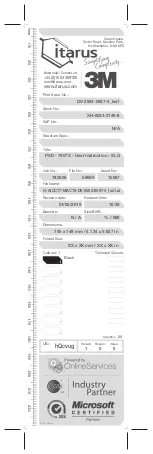
NOTES REGARDING ALLERGIC
REACTIONS
Materials which may come into contact with the
wearer's skin are not known to cause allergic reactions
to the majority of individuals.
These products do not contain components made from
natural rubber latex.
Please read these instructions in conjunction with the
appropriate 3M™ Filter Leaflet or 3M™ Air Supply Unit
User Instructions where you will find information on:
• Approved combinations of 3M™ Air supply units and /
or 3M™ Filters
• Accessories
• For spare see (Fig 1)
SYSTEM DESCRIPTION
These products meet the requirements of EN
136:1998, full face masks and should be used in
combination with a pair of approved 3M filters to form a
filtering apparatus for respiratory protection.
Such an apparatus is designed to remove potentially
harmful gases, vapours and / or particulates from the
surrounding atmosphere.
This apparatus may also be used as a system with the
3M Air Supply Units.
PREPARATION FOR USE
Inspect the package contents for shipping damage and
ensure all components are present.
Check apparatus is complete, undamaged and
correctly assembled. Any damaged or defective parts
must be replaced with original 3M spare parts before
use.
Inspection
The following inspection procedure is recommended
before use:
1. Check the facepiece for cracks, tears and dirt. Be
certain the facepiece, especially the face seal area, is
not distorted. The material must be pliable – not stiff.
2. Examine the inhalation valves for cracks or tears. Lift
valves and inspect valve seat for dirt or cracks.
3. Ensure that the head straps are intact and have good
elasticity.
4. Examine all plastic parts for signs of cracks or fatigue.
5. Make sure all gaskets are properly seated.
6. Remove the exhalation valve cover and examine the
exhalation valve and valve seat for signs of dirt,
distortion, cracks or tears. Replace the exhalation valve
cover.
7. Inspect lens for any damage that may impair
respirator performance or vision.
ASSEMBLY INSTRUCTIONS
See appropriate User Instructions for assembly
instructions (e.g. 3M™ Filter/3M™ Air Supply Unit).
FITTING INSTRUCTIONS
Fitting Instructions must be followed each time the
product is worn.
DONNING
1. Fully loosen all 6 head straps, then place harness on
the back of the head and pull the facepiece down over
the face (Figure 2).
2. Pull the ends of the 6 straps to adjust the tightness,
starting with the neck straps first, followed by the temple
straps.
Do not overtighten.
3. Perform a positive and/or negative pressure face fit
check.
The Negative Pressure Fit Check is recommended
when using the 6035 and 6038 or 2000 Series filters,
whereas the Positive Pressure Fit Check is
recommended when using other 3M filters.
DOFFING
Do not remove the facepiece, filters or, when in
Supplied Air mode, turn off the air supply until you
have vacated the contaminated area.
1. Release the tension on the head straps.
2. Carefully lift facepiece off the face and remove the
respirator by lifting up and away from the face.
See Figure 6.
FIT CHECK
• Positive Pressure User Seal Check (for all
approved configurations)
(all Filters except 3M™ 6035 /6038/ 2000 Series
Filters).
Place palm of hand over exhalation valve cover and
exhale gently.
If the facepiece bulges slightly and no air leaks are
detected between the face and the facepiece, a proper
seal has been obtained.
If an air leak is detected, reposition the respirator on the
face and / or re-adjust the tension of the elastic strap to
eliminate the leakage.
Repeat the above fit check.
• Negative Pressure User Seal Check with 6035 /
6038 Filters
Also 2000 Series filters.
Press your thumbs into the central indentation of the
filters (2000 Series), or press filter cover and filter body
together (6035/38), inhale gently and hold your breath
for five to ten seconds.
If the facepiece collapses slightly a proper fit has been
achieved.
Figure 3. Figure 4.
If an air leak is detected, reposition the respirator on the
face and / or re-adjust the tension of the elastic strap to
eliminate the leakage.
Repeat the above fit check.
If you CANNOT achieve a proper fit DO NOT enter
the hazardous area.
Quantitative Fit Testing
For information regarding fit testing procedures, please
contact 3M.
6
Summary of Contents for 7907S
Page 3: ...7283 7910 7882 7918 7883 7924 7893 7925 7282 7928 7989 7992 7927 7895 1 1 2 ...
Page 5: ...2 1 3 2 4 5 6 7 4 ...
Page 126: ...125 ...
Page 127: ...126 ...
Page 129: ......

























